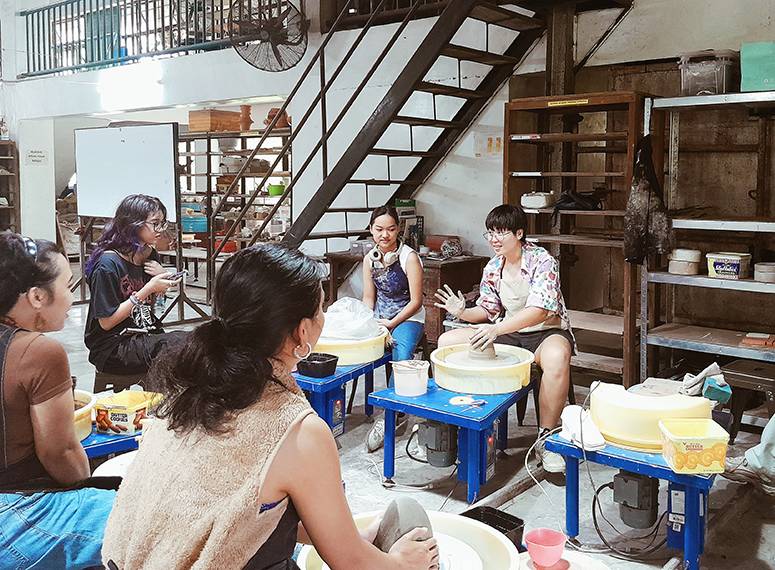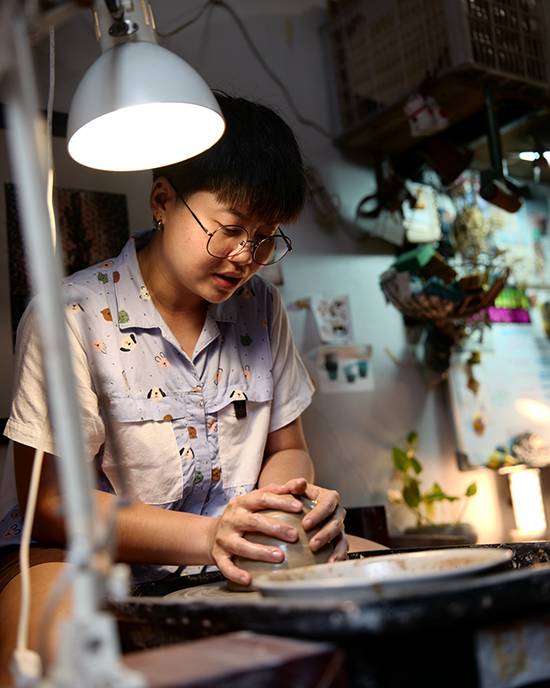Jezzel Wee: Shaping kinships out of clay
When I meet Jezzel Wee, she is keeping a calm eye on her students at the Ceramics Studio of the University of the Philippines College of Fine Arts. Three are kneading a shapeless lump of clay on a wide working table; a few others are stationed on the potter’s wheel; while the rest are busy with their brushes applying glaze. “Hindi ’to parang painting on canvas,” their teacher reminds them; one stroke goes a long way. That faint, translucent, watery blue would turn into a deeper darker color once it’s fired on the kiln.
While Wee mentors these young students, taking them through the basics of shaping bowls and cylinders, and then eventually sculptural ceramics, she also manages the operations of the university’s ceramics studio. Are there enough raw materials to be mixed? Which among the tubs of glaze need refilling? Is there enough or too much oxygen in the kiln to achieve certain effects?

“Access to materials is easier now compared to before,” Wee muses. In the Philippines, Jon and Tessy Pettyjohn, Ugu Bigyan and Joey de Castro are some of the noted ceramics practitioners who became mentors to younger creatives. There is a wide gap between Wee’s generation and theirs. Apart from a few key names who move between exhibition circuits and quirky design stores, Wee observes that so few artists have chosen to focus on the medium. “Now, there are local manufacturers of kilns and wheels. I remember before, Sir Jon (Pettyjohn) would say that they source their clay from scratch and they build their own kilns. Or kung may pera ka, you buy abroad and bring it here.”
Wee regards ceramics as a medium that is “open for collaboration.” Skills and access to equipment are shared; people come to fire their clay like they’re going to a house for a potluck party.
This sense of spontaneous kinship is somehow reflected in Wee’s project for Art Fair Philippines. Called “Pagbulong,” the exhibition invites viewers to hold her pieces, wish upon them, and make ringing sounds. The form is inspired by Daruma dolls; in Japan, they are the handmade and handheld figures that witness their owner’s wish (two eyes drawn on a doll signify a wish fulfilled). In the middle of a busy Art Fair, the artist imagines it as a meditative experience, a momentary immersion into sound and one’s own turning thoughts.

It was in Japan where Wee became more deeply grounded in the round-the-clock labor and discipline of ceramics. For three years, she was an apprentice under master potter Ryoji Matsumiya, in the pottery company Tsugaru Kanayama-yaki. The factory is located in Aomori prefecture, an area with the most snowfall in rural Japan, where very few spoke English. There was the strenuous physical work—managing a climbing kiln alone on six-hour evening shifts—and then the everyday challenge of learning a foreign language through conversation. “Every February, (we would go to) Tokyo for a tableware festival,” she recalls. “I had to learn how to sell ceramics in Japanese!”
Her works for the Art Fair are mostly wheel-thrown while others are slip casted. The objects look identical—they are a swarm of spherical ceramic heads—but variations arise from the glaze and the type of firing. Most were fired in a gas kiln. Some were encased in saggar, its reduced atmosphere creating a metallic sheen. Inside each piece, Wee has placed a ball of clay so it may ring like a bell at a subtle turn or shake.
The outcome of all this meticulous, fragile labor is now placed under the viewer’s care. “Aren’t you nervous?” I ask the artist. “I trust the viewers to take care of it,” she tells me calmly.
Even at her first solo exhibition at Gravity Art Space in 2023, Wee shows an appetite for risk. Ceramics, alongside crocheted yarns resembling the fibrous material of kapok pods, dangle from the ceiling through wires embedded in the clay. Fragile, yes, but there’s also something self-assured and defiant in the gesture. Ceramics and crochet are mediums conventionally regarded as craft, but there at the exhibition, they recall a hint of the marvelous, awe-inducing immediacy of installation art.
Francisco Lee, the ceramics practitioner who curated Wee’s first exhibition, remarks that in the Philippines, “there is a lot of hesitation in holding (ceramics shows, because of) what one could say are avoidant considerations, like it’s hard to sell or it’s easy to break.” In countries like Japan, he observes that exhibitions of sculptural and even functional ceramics are not uncommon, as the craft is deeply embedded in traditions like tea ceremonies, which “rely on a body of ceramic pieces to fulfill its performative aspects.”
Functional ceramics may not often carry a ritualistic function in the Philippines, but it does invite a quiet intimacy. “Iba kapag wheel-thrown or handbuilt,” Wee says of functional ware. “Mapapansin mo ’yong throwing lines ng potter, kung paano niya ginawa ’yong lip ng cup, ’yong proportion ng handle. As the user, mayroon kang insight sa process ng maker. As you use it every day, you notice nuances, small details.”
It is this tactile intimacy that Wee wants to cultivate by having her viewers hold her works. Pagbulong does away with the intimidation of an art object beheld at a distance. Held close, it functions more like a totem object, a little embodiment of kinship. Blow a wish upon it and you hear a dozen other dolls around you ringing, answering back.



